

Christmas dinner

What is it?
Christmas dinner is a meal traditionally eaten at Christmas. This meal can take place any time from the evening of Christmas Eve to the evening of Christmas Day itself. The meals are often particularly rich and substantial, in the tradition of the Christian feast day celebration, and form a significant part of gatherings held to celebrate Christmas. In some cases, there is a ritual element to the meal related to the religious celebration.
The actual meal consumed varies in different parts of the world with regional cuisines and local traditions. In many parts of the world, particularly former British colonies, the meal shares some connection with the English Christmas dinner involving roasted meats and pudding of some description. The Christmas pudding and Christmas cake evolved from this tradition.
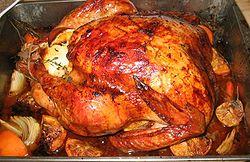
 The United Kingdom
The United Kingdom
Christmas dinner in the United Kingdom is usually eaten in the afternoon on 25 December. The dinner usually consists of turkey served with stuffing, gravy and sometimes pigs in blankets; devils on horseback, cranberry sauce or redcurrant jelly; bread sauce; yorkshire pudding, roast potatoes (sometimes also boiled or mashed); vegetables (usually boiled or steamed), particularly brussels sprouts and parsnips; with dessert of Christmas pudding (or plum pudding), sometimes mince pies or trifle, with brandy butter and/or cream.
1 sprig of fresh sage
12 strips higher-welfare pancetta or thinly sliced streaky bacon
1 bulb garlic
4 medium red onions
2 sticks celery
1 big handful of breadcrumbs
1 handful of dried apricots
300 g higher-welfare minced pork
1 lemon
1 pinch of grated nutmeg
1 large free-range egg
12 small sprigs of fresh rosemary , plus a few extra
4-4.5 kg higher-welfare turkey , at room temperature
2 carrots
1 large orange
olive oil
2 tablespoons plain flour
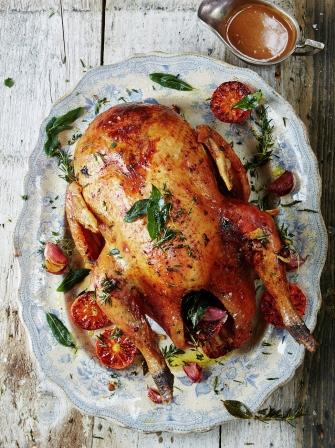 1.1 litres organic chicken or vegetable stock
1.1 litres organic chicken or vegetable stock
Preheat the oven to maximum. Heat a saucepan until medium hot and add a splash of olive oil. Pick the sage leaves and add to the pan with 6 of the pancetta or bacon strips.
Peel and chop 2 garlic cloves and 1 onion. Trim and chop the celery and add to the pan with the garlic and onion. Fry everything gently until soft and golden brown. Take the pan off the heat, add the breadcrumbs and, while the mix is cooling down, roughly chop the apricots and stir them in.
When the stuffing has cooled down, add the pork, lemon zest, nutmeg, egg and lots of sea salt and freshly ground black pepper, and mix everything together well.
Slice the remaining strips of pancetta or bacon in half and peel and slice 1 peeled garlic clove into thin slivers. Place a rosemary sprig and a garlic sliver on one end of a halved strip of pancetta and roll it up tightly. Repeat with the other pieces of pancetta until you have 12 little rolls.
Stab the thighs and drumsticks of the turkey in 6 places on each side. Push a little pancetta roll into each hole until it just peeps out. This will give your turkey thighs a fantastic flavour and will keep them moist while they cook.
Peel the remaining onions and chop in half, and peel and thickly slice the carrots.
Give your turkey a good wipe, inside and out, with kitchen paper, and place it on a board, with the neck end towards you. Find the edge of the skin that's covering the turkey's breasts and gently peel it back. Work your fingers and then your hand under the skin, freeing it from the meat. If you're careful you should be able to pull all the skin away from the meat, keeping it attached at the sides. Go slowly and try not to make any holes!
Lift the loose skin at the neck end and spoon the stuffing between the skin and the breast, tucking the flap of skin underneath to stop anything leaking out. Pop the orange in the microwave for 30 seconds to warm it up and stuff it into the cavity.
Weigh the stuffed turkey and calculate the cooking time (about 20 minutes per 500g/1lb 2oz).
Place the bird on a large roasting tray, rub it all over with olive oil and season well. Surround with the chopped carrots, onions and remaining cloves of garlic, cover with tin foil and place in the preheated oven. Turn the heat down right away to 180°C/350°F/gas 4 and roast for the calculated time, or until the juices run clear from the thigh if you pierce it with a knife or a skewer. Remove the tin foil for the last 45 minutes to brown the bird.
Carefully lift the turkey out of the tray and rest on a board covered loosely with foil for at least 1 hour, preferably 2 hours for bigger birds.
When the resting time's nearly up, skim off the surface fat from the roasting tray and add the flour and stock. Place the tray on the hob and bring to the boil on a high heat. When the gravy starts to thicken, strain it into a bowl.
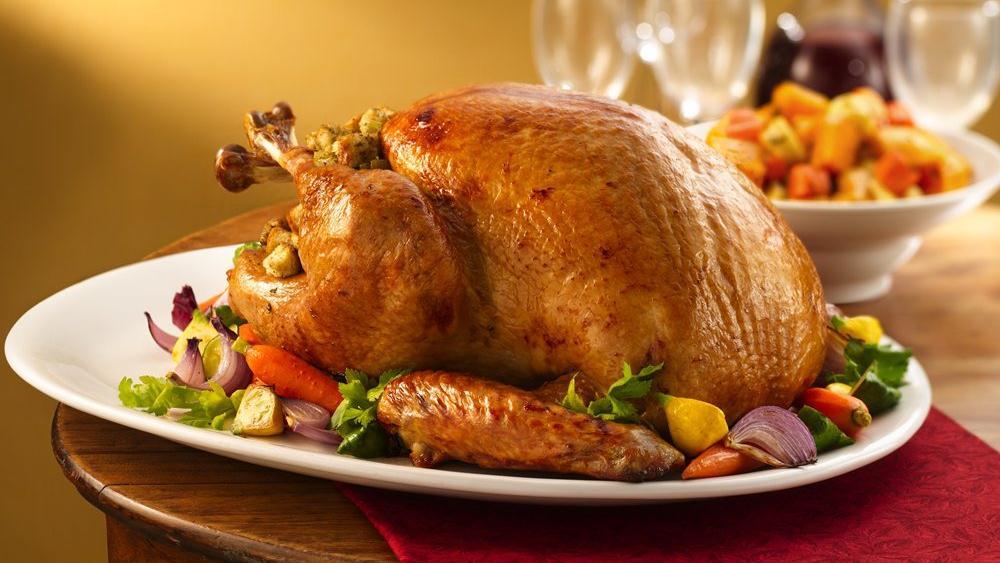 Carve your turkey, serve with the gravy and dig in!
Carve your turkey, serve with the gravy and dig in!
Christmas Pudding
Christmas pudding is the dessert traditionally served on Christmas Day in the United Kingdom (especially England) and some other Commonwealth countries such as Australia, New Zealand and Canada. It is sometimes known as plum pudding, though this can also refer to other kinds of boiled pudding involving a lot of dried fruit.
The pudding needs to be made and cooked well in advance, to allow the flavours to mix (and to save the cook labour on Christmas Day); it is merely reheated when it is to be eaten.
The following is a Sussex recipe for Christmas pudding that is known to have been in annual use for over 50 years without a break, and is believed to have been used largely unaltered since the late nineteenth century, despite the difficulties in gathering the ingredients during the rationing in force in the UK in two world wars. All measurements are in imperial units (with metric measurements in brackets), generally meaning that volume measurements are 20% larger than with the Queen Anne units used in the USA. Originally, twice or even four times these quantities would have been made.
C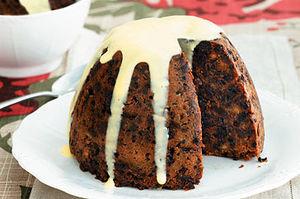 ook Time: 10 minutes preparation, 2 hours cooking
ook Time: 10 minutes preparation, 2 hours cooking
Ingredients
½ pound (lb) (225g) raisins
¾ lb (340 g) currants
½ lb (225 g) sultanas
½ lb (225 g) sugar (or less)
¾ lb (340 g) shredded suet (can be vegetarian; see note below)
½ lb (225 g) breadcrumbs
¼ lb (110 g) crystallized orange peel
2 teaspoons (tsp) cinnamon
2 oz (55 g) almonds (chopped, but not too small)
⅓ cup (about 60 g) flour
⅓ pint (about 190 ml) milk
3 large eggs (beaten)
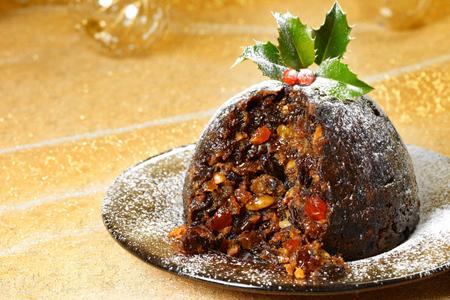 brandy
brandy
juice and rind of 1 lemon
⅓ of a nutmeg
Directions
Mix and stir well.
Place in pudding basins, and cover with cloths or buttered greaseproof paper, tied tightly in place with string.
Steam for 7 hours and keep till Christmas Day.
To prepare for serving, steam for 2 hours.
Times can be reduced by using a pressure cooker.
Notes
Suet can be difficult to find in some countries, e.g. the USA. Butter is an excellent substitute. Some recipes may tell you that you have to freeze and grate the butter, but this doesn't work properly. The butter immediately starts softening and forms a giant cold lump. A better way to incorporate the butter in the mixture, is to melt it in a microwave or saucepan, and pouring in into your mixing bowl.
It was common practice to include small silver coins in the pudding mixture, which could be kept by the person whose serving included them. The usual choice was a silver 3d piece (the threepence), or a sixpence. However this practice fell away once real silver coins were not available, as it was believed that alloy coins would taint the pudding.
Christmas puddings are often dried out on hooks for weeks prior to serving in order to enhance the flavor.
Once turned out of its basin, the Christmas pudding is traditionally decorated with a spray of holly, then dowsed in brandy, flamed, and brought to the table ceremonially - where it should be greeted with a round of applause. It is best eaten with brandy butter, cream (lemon cream is excellent) or custard. Christmas puddings have very good keeping properties and many families keep one back from Christmas to be eaten at another celebration later in the year.
Christmas puddings are often dried out on hooks for weeks prior to serving in order to enhance the flavor.
 The Russian Federation
The Russian Federation
Olivier salad is a traditional salad dish in Russian cuisine, which is also popular in many other European countries, Iran, Israel, Mongolia and also throughout Latin America. In different modern recipes, it is usually made with diced boiled potatoes, carrots, brined dill pickles, green peas, eggs, celeriac, onions, diced boiled chicken (or sometimes ham or bologna sausage), tart apples, with salt, pepper, and mustard added to enhance flavor, dressed with mayonnaise. In many countries, the dish is commonly referred to as Russian salad, although this term can connote vinegret[citation needed]. A variation called Stolichny salad (Russian: салат столичный, "capital city salad") exists, and is also popular in the Russian cuisine.
1lb of bologna
1 can (15 oz) of sweet peas
3 medium size potatoes
4-5 medium size carrots
5-6 eggs
1 bunch of green onions
1 bunch of fresh dill
5-6 medium size cucumbers (pickled with salt not with vinegar, that is important
Ground black pepper
Salt by taste
Mayonnaise by taste
Boil carrots and potatoes in advance and make sure they cool till room temperature when you start making the salad. Prepare hard boiled eggs in advance, let them to cool down to room temperature as well. Wash green onions and dill.
Skin boiled potatoes and dice them into small cubes.
Skin boiled carrots and dice them into the cubes of the same size you diced potatoes.
Put diced carrots and potatoes into big bowl.
Open can with peas and remove liquid, add to the bowl.
Peel eggs and dice them into the same size pieces as carrots and potatoes. Add the to the bowl.
Dice bologna, add to the bowl.
Dice pickled cucumbers. It is important to take cucumbers pickled with salt not with vinegar.
Chop green onions and dill, add to the bowl.
Mix everything, season with ground black pepper and add salt if you feel it is needed. Add mayonnaise and mix everything again. Put salad to the bowl you want to serve it in. Your Russian Salad Olivier is ready to be served!


 Получите свидетельство
Получите свидетельство Вход
Вход



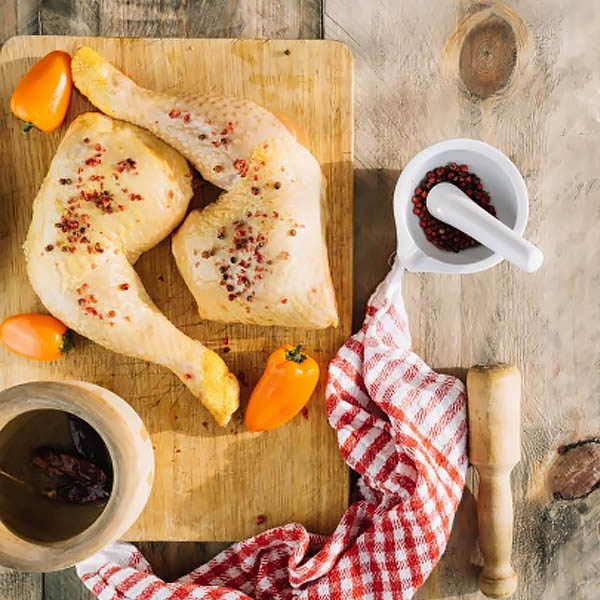








 Christmas dinner (932.37 KB)
Christmas dinner (932.37 KB)
 0
0 221
221 2
2 Нравится
0
Нравится
0


